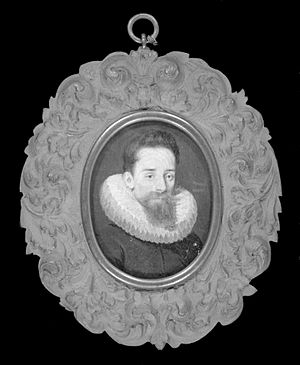George Christian, Landgrave of Hesse-Homburg facts for kids
Quick facts for kids George Christian, Landgrave of Hesse-Homburg |
|
|---|---|
 |
|
| Georg Christian von Hesse-Homburg | |
| Spouse(s) | Anna Catharina of Pogwitsch |
| Noble family | House of Hesse |
| Father | Frederick I, Landgrave of Hesse-Homburg |
| Mother | Margaret Elisabeth of Leiningen-Westerburg |
| Born | 10 December 1626 Homburg |
| Died | 1 August 1677 (aged 50) Frankfurt |
George Christian was an important figure in German history. He was the third Landgrave of Hesse-Homburg, a small state in Germany. He was born on December 10, 1626, in Homburg and passed away on August 1, 1677, in Frankfurt.
Contents
Early Life
George Christian was the fifth child of Landgrave Frederick I of Hesse-Homburg. His father died in 1638 when George Christian was still young. After his father's death, he and his siblings were raised by their mother, Margaret Elisabeth of Leiningen-Westerburg.
Military and Political Work
In 1648, George Christian joined the Spanish army. He served there until 1653, reaching a high rank as a "Capitan General." During this time, in 1651, he changed his religion to Catholicism. Some believe he did this to improve his career chances in the Spanish army.
After leaving the Spanish service, George Christian went to France. He hoped to find success in the French army. In 1656, he was promoted to Lieutenant General. He tried to create his own army units, but he wasn't successful.
However, he played a key role in politics. In 1658, he helped as a mediator for the French Cardinal Mazarin. This was during the important imperial election of 1658, where a new Holy Roman Emperor was chosen. He also helped with talks that led to the creation of the Rhenish Alliance in the same year. This alliance was a group of German states that worked together.
Around 1660, George Christian spent some time in Saxony. He visited the court of Duke William in Weimar. He joined a group called the Fruitbearing Society. This society worked to promote the German language and culture. He was known there by the nickname "the Brave."
In September 1665, he served as a commander in the Netherlands. He led an army allied with the King of England. This military effort was about controlling a place called Borculo. However, France and Brandenburg stepped in, which was not good for his side.
Troubles in Hanau
In 1669, George Christian was involved in a big dispute in Hanau. This event was known as the "mad year." It was a disagreement between the ruler, Count Frederick Casimir, and his family. The count had serious money troubles and made big, expensive plans. One of these plans was to create a colony called the Hanauish Indies in South America.
George Christian was an advisor to Frederick Casimir. To solve the money problems, Frederick Casimir thought about selling parts of his land. He even considered changing his religion to Roman Catholicism to get support. George Christian bought a district called Rodheim from him. He then tried to buy another important area, Dorheim, which included a valuable salt mine.
To gain more power, George Christian tried to become a co-ruler of Hanau. This upset Frederick Casimir's relatives, who were against selling off land. They took strong action and staged a coup d'état, which means they suddenly took control. After long discussions, Emperor Leopold I made a decision. He appointed other family members as co-rulers to oversee Frederick Casimir's decisions. Their position was supported by the army of Hesse-Kassel. George Christian and other advisors were released.
Hesse-Homburg Changes Hands
Also in 1669, George Christian bought Hesse-Homburg from his brother William Christoph. However, he did not keep it for long. In 1671, he sold Hesse-Homburg to two of his main creditors, Johann Christian von Boyneburg and the banker Johann Ochs. They then sold Hesse-Homburg to Landgrave Louis VI of Hesse-Darmstadt in 1673.
Marriage
On October 11, 1666, George Christian married Anna Catharina of Pogwitsch in Hamburg. She was the widow of Frederick of Ahlefeldt. Their marriage did not seem to be a happy one. By 1668, George Christian was back in Homburg, while his wife stayed in northern Germany.
Death and Burial
George Christian passed away on August 1, 1677, in Frankfurt am Main. Unlike most Landgraves of Hesse-Homburg, he was not buried in the family crypt in Homburg. Instead, his grave is located near the southern entrance of the crypt below Mainz Cathedral.
See also
 In Spanish: Jorge Cristián de Hesse-Homburg para niños
In Spanish: Jorge Cristián de Hesse-Homburg para niños

